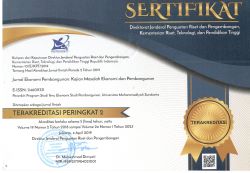Impacts Seed Technology Improvement on Economic Aspects of Chilli Production in Central Java - Indonesia
Joko Mariyono(1*)(1) Postgraduate School of Management, University of Pancasakti - Tegal
(*) Corresponding Author
Abstract
Vegetable production, including that of chillies, plays an important role in agricultural sector and rural economic development worldwide. This is because of greater farm productivity with regard to vegetables than cereal and staple crops. This paper analyses the impact of seed technology development on the economic aspects of chilli production in Central Java. Particular attention is paid to improved varieties of chilli. Potential consequences of seed technology development are discussed. Data of this study are compiled from surveys conducted in three selected chilli producing regions in 2010-2012. The results show that the major varieties of chilli grown by surveyed farmers are grouped into three broad types: hybrids, local and improved open pollinated varieties. The chilli varieties farmers selected varied according to location and cropping season. In the dry season, farmers grew similar proportions of hybrid, local, and open pollinated types. Nevertheless, there were differences among the survey sites. Farmers grew different varieties to exploit seasonal microclimates and market preferences. Mostly, farmers selected varieties for economic motives. The consequence of growing hybrids was less use of agrochemicals, particularly pesticides, than for other varieties. Overall, they show the best economic performance in the study site. Development of seed technology should consider agro-ecological and economic aspects to obtain better outcomes. Private sector and national research institutions need to collaborate more to utilise available genetic resources to produce better varieties of chilli.
Keywords
Full Text:
PDFReferences
Ali M. (2008). Horticulture Revolution for the Poor: Nature, Challenges, and Opportunities. A background paper prepared for IAAST, World Development Report/World Bank 2008.
Ali M. (ed.) 2006. Chili (Capsicum spp) Food Chain Analysis: Setting Research Priorities in Asia. Shanhua, Taiwan: AVRDC – The World Vegetable Center, Technical Bulletin No. 38, AVRDC Publication 06-678.
Antara News (2014), “Indonesia inflation exceeds target on food price hikes”, Finance Minister, http://www.antaranews.com/en/news/92052/indonesia-inflation-exceeds-target-on-food-price-hikes-finance-minister (accessed 28 March 2014)
BBC-News (2011), “Indonesians urged to grow chillies to combat price rise”, BBC-NEWS, ASIA-PACIFIC, 6 January 2011
BPS (2011), Monthly Data Report of Social and Economic. 9th Ed., Indonesian Statictical Agency, Jakarta, 2011.
BPS (2013), Indonesia Year Book. Indonesian Statistical Agency, Jakarta.
FAOSTAT (2013), FAO-STAT online. Rome: United Nations Food and Agriculture Organization. http://faostat.fao.org/default/aspx?lang-en (accessed 4 March 2014)
Feder, G., Just, R.E. and Zilberman, D. (1985), “Adoption of agricultural innovations in developing countries: a survey”, Economic Development and Cultural Change, Vol. 33 No. 2, pp. 255-98.
Global Indonesian Voices (2014), “Chili is becoming a luxury in Indonesia”, Global Indonesian Voices, March 28,
Jayne, T.S., Haggblade, S., Minot, N., and Rashid, S. (2011), “Agricultural commercialization, rural transformation and poverty reduction: what have we learned about how to achieve this?” Synthesis report prepared for the African Agricultural Markets Programme Policy Symposium, Alliance for Commodity Trade in Eastern and Southern Africa April 20-22, 2011, Kigali, Rwanda.
Johnson G.I., Weinberger K., Wu M.H. (2008). The Vegetable Industry in Tropical Asia: An overview of production and trade, with a focus on Thailand, Indonesia, the Philippines, Vietnam, and India [CD-ROM]. Shanhua, Taiwan: AVRDC – The World Vegetable Center. 56 pp. (Explorations series; no. 1).
Johnston J., Di’Nardo J. (1997). Econometric Methods. McGraw-Hill Co. Inc. New York.
Juniman (2013), “Yearly inflation increase, but the BI rate remains on hold”, BII Economic Research, February 2013.
Kikuchi, M. (1991). Factor share in agricultural production: definition, estimation and application. In: IRRI, Basic Procedures for Agroeconomic Research, IRRI, Manila, Philippines pp. 83-98.
Maddala, G.S. 1983. Limited Dependent and Qualitative Variables in Econometrics. Cambridge University Press.
Mariyono, J. and Bhattarai, M. (2011), Revitalizing Indonesian rural economy through intensive farming of high value vegetables: a case of chili farming in Central Java. B.E. Afianto, B.P. Resosudarmo, D.S. Priyarsono, A.A. Yusuf (Eds.) Indonesia’s Regional Economy in the Globalization Era. Airlangga University Press, Surabaya, pp. 71-89.
Mariyono, J. and Bhattarai, M., (2009), Chili Production Practices in Central Java, Indonesia: A Baseline Report. AVRDC- The World Vegetable Center, Taiwan.
Mariyono, J. (2015). Green revolution- and wetland-linked technological change of rice agriculture in Indonesia. Management of Environmental Quality: an International Journal, 26 (5), 683-700.
Mariyono, J., Sumarno (2015). Chilli production and adoption of chilli-based agribusiness in Indonesia. Journal of Agribusiness in Developing and Emerging Economies, 5 (1), 57-75.
O'Loughlin, T. (2011), “Red hot chilli prices bring a tear to the eye”, Sydney Herald Morning, January 8, 2011.
Webb, A. J. and Kosasih, I. A. (2011), “Analysis of price volatility in the Indonesia fresh chili market.” Paper presented to the Annual Meeting of the International Agricultural Trade Research Consortium, December 11~13, 2011, Tampa, FL, USA.
Webb, A. J., Kartikarsari, F. G. and Kosasih , I. A. (2012), “Do chili traders make price volatility worse? a qualitative analysis of East Java trading practices” (November 15, 2012). Available at SSRN: http://ssrn.com/abstract=2176153 (accessed 12 March 2014)
Weinberger K, and Lumpkin T.A. (2007), “Diversification into horticulture and poverty reduction: A research agenda”, World Development, Vol. 35 No. 8, pp. 1464-80.
White, B., Morey, P., Natawidjaja, R. and Morgan, W. (2007), Vegetable value chains in Eastern Indonesia–a focus on chilli. SADI-ACIAR Research Report, Indonesia Australia Partnership.
Wicaksena, B. and Permani, R. (2011), “Indonesian chilli farmers’ participation at the supermarket channel”. GoLive Indonesia, October 2011.
Wijayanto, H., Sumertajaya, I. M., Fitrianto, A., Wahyuni, S. (2014), “Statistical models for chili productivity”, Applied Mathematical Sciences, Vol. 8 No. 2, pp. 69-79.
Article Metrics
Abstract view(s): 1345 time(s)PDF: 842 time(s)
Refbacks
- There are currently no refbacks.















